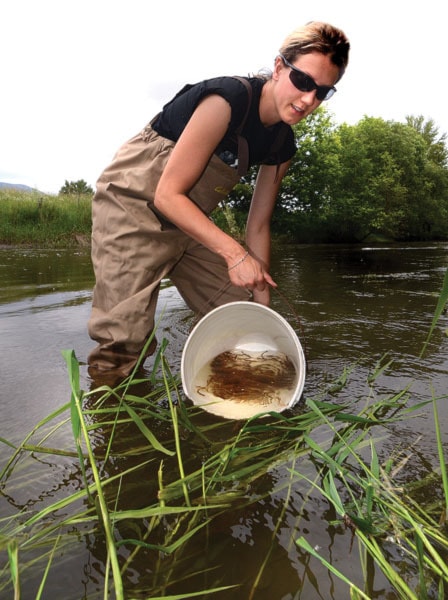Something fishy is going on in the Salmon River.
The federal Department of Fisheries and Oceans has once again added hundreds of thousands of fish to the river.
Every fall, technicians from the department’s Spius Hatchery near Merritt take several coho that are halted in their upriver travels by the Silver Creek fish fence operated by Eugene Puetz.
The salmon are taken to the fish hatchery where technicians remove eggs from the females for rearing in the hatchery.
“The purpose of the hatchery is to enhance wild stock,” says Doug Allen, a DFO enhancement technician, who notes both smolts that weigh in at about 15 to 18 grams and the younger fry that weigh only 1.5 grams are added to the river every spring. The smolts are about 28 months old and will travel to the ocean the same spring, he says, while the younger fry will rear in the Salmon River for about eight months and depart the following spring.
On June 22 and 27, 130,000 coho fry were released in the river and hatchery officials released 98,000 chinook on June 13 and 14.
Earlier in the year on May 13, 6,700 coho smolts were released and stand a much better chance of survival than the younger and smaller fry.
“The fry have to live in the river for another eight months and are prey to birds, other fish, snakes, mother nature, temperature and oxygen issues as well,” says Allen, who notes technicians from Spius Hatchery have been trying to enhance Salmon River salmon stocks for about 15 years, releasing the smolts and fry into several locations along the river, beginning at Falkland.
“We know how many fry we have and we want to spread them out over 27 kilometres from Falkand to Salmon Arm,” he says. “We spread them out when water is higher and coloured so they can hide better. It’s not an exact science, but it’s the best chance we can give them.”
And science or not, the enhancement project seems to be working.
“We’re up a bit, which is good news,” says fish fence operator Eugene Puetz.
Last year, 660 chinooks made their way to the fence between July and October, that’s up from 618 the previous year. The peak of the annual coho run is around the last week of October and last year’s return was 1,197, up from the previous year’s 1,007 salmon.
The biggest jump was in the sockeye run.
“We had 323 sockeye through the trap where four years previously we had 46, that’s a significant jump,” he said.
That jump can likely be attributed to sockeye who came to the Salmon River because of overcrowding on the Adams River.
